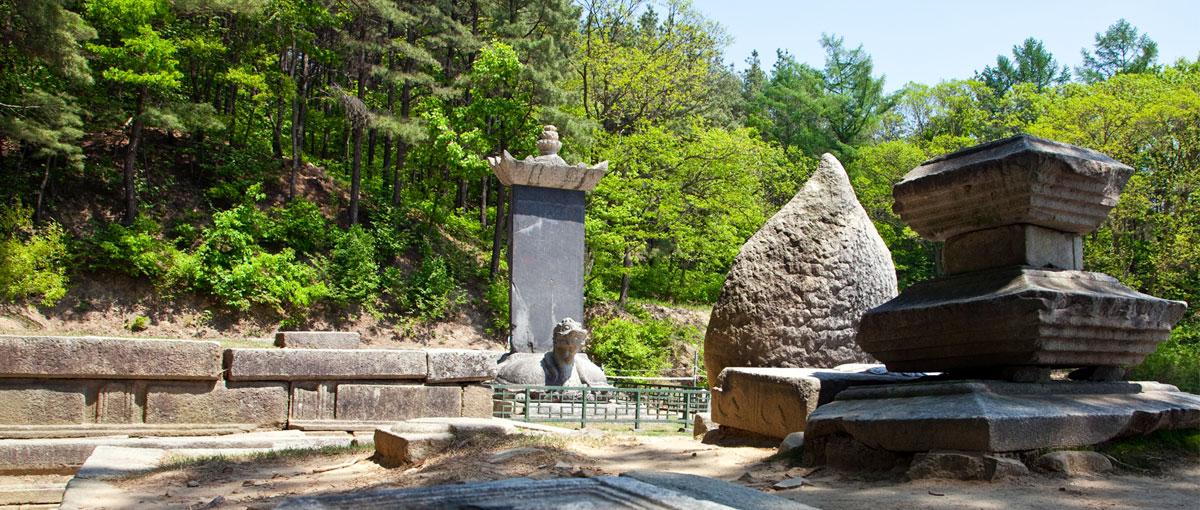Monument for State Preceptor Jigwang at Beopcheonsa Temple Site, Wonju (No. 59)

(National Treasure No. 59)
Stele for State Preceptor Jigwang
at Beopcheonsa Temple Site
Status
National Treasure No. 59
Address
San 74 beonji, Beopcheon-ri. Buron-myeon, Wonju-si
Directions (by car)
Wonju Intercity Bus Terminal - About 5 minutes after passing Namwonju IC on Jungang Expressway - About 9 minutes after passing Manjong Junction on Yeongdong Expressway - Turn left at Munmak IC toward Yeoju/ Buron (Wonmun-ro) - Beopcheonsa Temple Site in Wonju
Period
It is a stele that carries inscriptions about the achievements of Goryeo's State Preceptor Jigwang in the 11th century (1085, 2nd year of King Seonjong).
History
This stele is inscribed with the achievements of State Preceptor Jigwang. The Stupa for State Preceptor Jigwang where his sariras are enshrined (National Treasure No. 101) was found near this stele, to be later moved to the present location, Gyeongbokgung Palace. This stele, praised as a masterwork that represents the 11th century's stone steles, was made with light green slate. The inscriptions were created by Jeong Yu-san, a renowned writer of the early Goryeo, and were written by An Min-hu in Ouyang Xun style. The front side of the stele is inscribed with the history of State Preceptor Jigwang's monastic life.
State Preceptor Jigwang (Buddhist name: Haerin) was a member of the Won clan, one of the powerful families native to Wonju. Haerin completed training under Great Master Gwanung from Beopgosa Temple. Following Great Master Gwanung, he went to Gaegyeong where he joined the monastic order under Great Master Jungwang. At the age of 16, he received upasampada (higher ordination) at Yongheungsa Temple. In 1004 (7th year of King Mokjong), at the age of 21, Haerin passed the seungkkwa (national monastic examination) and was given the title of "Daedeok" as a priest of the Dharmalaksana Sect. During the early Goryeo era, King Hyeonjong founded Hyeonhwangsa Temple and actively supported the Dharmalaksana Sect. Haerin, appointed the abbot of the temple at the age of 71 in 1054 (8th year of King Munjong), led the scripture engraving projects.
He was awarded higher titles and ranks such as "Samjungdaesa," "Seungtong," and "Wangsa," and was appointed State Preceptor (Guksa) in 1057 (11th year of King Munjong) when he was 74 years at Bongeunsa Temple that he served until he passed away in 1070 (24th year of King Munjong). On the back of the stele are the names of his over 1370 disciples. According to the inscriptions, the stele was erected in 1085 (2nd year of King Seonjong of Goryeo).
Architectural features
This stele was standing in the vicinity of the Stupa for State Preceptor Jigwang, which was later relocated to Gyeongbokgung Palace.
Given the square cornerstones arranged around the foundation stone, it is presumed that the stele was initially in a pavilion that protected it.
The main structure of the stele was erected by building a square pedestal with grooves on top of the gwibu (turtle-shaped base),
and then cutting corresponding ridges on the bottom of the stele to put them into the grooves.
Isu (dragon-shaped cover), the upper part of the stele,
is composed of two floors, and the center of the upper floor has boryun (disk shaped ornaments) carved with
lotus flowers over the bokbal (inverted bowl shaped ornaments) delicately engraved with Mt. Sumeru, the Buddhist ideal world,
together with heavenly maids flying in the sky, the sun and the moon, which are commonly found in the upper part of pagodas.
The lower floor of the isu reflects the main structure of a pagoda, carved into a shape with four corners
open wide towards the sky like traditional roof eaves and flowers engraved in between, looking as if about to soar to the sky.
The remarkably beautiful carving of two lotus flowers and a dragon in clouds seen in the middle is regarded
as a creative reinterpretation of the traditional patterns of concave roof-end tiles in the Buddhist context.
The stylobate is made up of two-stage stone rods ,
which is different from that of the Stele for Great Preceptor Jinghyo at Heungnyeongsa Temple Site in Yeongwol, which has only one stone rod.